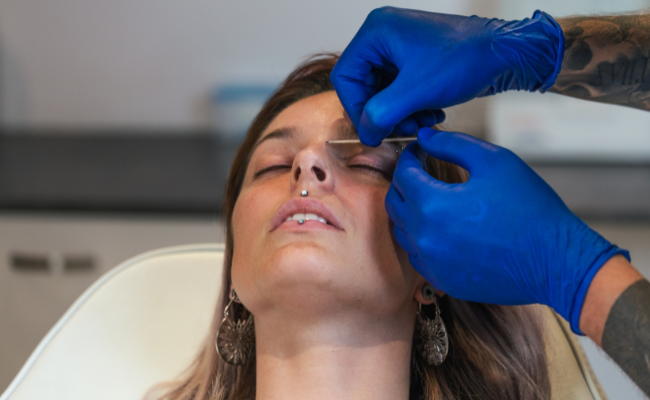How to Care for Body Piercings?
- November 28, 2023
- No Comments

What is Body Piercing?
Body piercing, a form of body modification, entails inserting jewelry into openings made in various body parts. While earlobe piercings are the most prevalent, individuals also opt for piercings in areas like the nose, eyebrows, lips, tongue, navel, and more intimate regions. This practice, rooted in cultural and personal motivations, has persisted for centuries as people seek to adorn their bodies with jewelry.
The process of body piercing involves creating an opening in the body using a needle, followed by the insertion of jewelry into that perforation. Commonly pierced regions encompass the ears, nose, and belly button, with oral piercings including the lip, cheek, and tongue.After a piercing has fully healed, individuals may choose to expand the hole to accommodate specific types of jewelry like plugs and tunnels. To minimize the risk of harm to the piercing and the development of scarring, it is crucial to approach stretching gradually and in small increments.
Why is Body Piercing Care Important?
Proper care for body piercings is crucial for preventing infections, promoting healing, and ensuring the longevity of the piercing. When a piercing is not cared for correctly, it can lead to complications such as infection, excessive bleeding, and scarring. The body perceives the piercing as a wound, and without proper care, it becomes susceptible to bacteria and other pathogens that can cause infections.
How to Care for Body Piercing?
Caring for a new body piercing requires diligence and attention to detail. Here's a step-by-step guide on how to care for body piercings:
- Clean Hands: Before touching the piercing, always wash your hands thoroughly with soap and water. Dirty hands can introduce bacteria to the piercing site, leading to infections.
- Cleaning Solutions: Use a saline solution or a specialized piercing aftercare solution to clean the piercing. These solutions help to cleanse the area without causing irritation. Avoid using alcohol or hydrogen peroxide, as they can be too harsh and delay the healing process.
- Gentle Cleaning: Gently clean the piercing with a cotton swab or a clean cloth. Avoid using rough materials that can irritate the piercing site.
- Avoid Rotation: While some piercers recommend rotating the jewelry during cleaning, it's not necessary for all types of piercings. Rotating jewelry can disrupt the healing process, so follow the advice provided by your piercer.
- Avoid Moisturizers and Ointments: Do not apply moisturizers, ointments, or creams to the piercing site. These can trap bacteria and hinder the healing process.
- Avoid Swimming: Stay out of pools, hot tubs, and bodies of water during the initial healing period. Exposure to bacteria in water can increase the risk of infection.
- Avoid Tight Clothing: Choose loose-fitting clothing that won't rub against or irritate the piercing. Tight clothing can slow down the healing process and cause discomfort.
- Be Mindful of Sleeping Positions: If your piercing is in an area that comes into contact with your pillow, be mindful of your sleeping position. Consider using a travel pillow or sleeping on the opposite side to avoid irritation.
Treatment Solutions for Common Piercing Issues:
- Infections: If you suspect an infection (signs include redness, swelling, pain, and discharge), clean the area more frequently with a saline solution. If the symptoms persist, consult a healthcare professional.
- Keloids and Scarring: Keloids are raised overgrowths of scar tissue that can occur at the piercing site. To minimize scarring, avoid touching or twisting the jewelry and follow proper aftercare.
- Allergic Reactions: Some individuals may experience allergic reactions to certain metals. If you notice persistent redness, itching, or swelling, consult your piercer to explore hypoallergenic jewelry options.
- Migration and Rejection: Sometimes, the body may reject the piercing, leading to migration or the jewelry being pushed out. If you notice signs of migration, consult your piercer promptly.
- Swelling and Discomfort: Mild swelling and discomfort are normal during the initial healing period. Over-the-counter pain relievers and cold compresses can help alleviate these symptoms.
Benefits of Proper Body Piercing Care:
- Faster Healing: Proper care accelerates the healing process, allowing you to enjoy your new piercing sooner.
- Reduced Risk of Infection: Regular cleaning reduces the risk of infection, ensuring the piercing site remains healthy and free from harmful bacteria.
- Minimized Discomfort: Following aftercare instructions minimizes discomfort, allowing you to go about your daily activities without unnecessary pain.
- Longevity of the Piercing: Taking care of your piercing ensures its longevity. A well-maintained piercing is less likely to experience complications that could lead to removal.
- Enhanced Aesthetic Appeal: A healthy, well-cared-for piercing looks better and enhances your overall aesthetic. Avoiding infections and complications ensures the jewelry remains a positive addition to your appearance.
Comments (0)